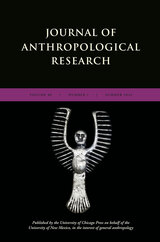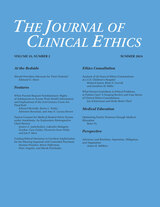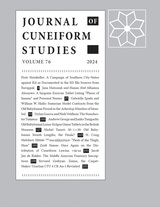300 scholarly books by Brandeis University Press and 15
start with A
300 scholarly books by Brandeis University Press and 15
300 scholarly books by Brandeis University Press
15 start with A start with A
15 start with A start with A
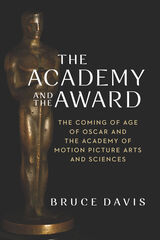
The Academy and the Award
The Coming of Age of Oscar and the Academy of Motion Picture Arts and Sciences
Bruce Davis
Brandeis University Press, 2022
The first behind-the-scenes history of the organization behind the Academy Awards.
For all the near-fanatic attention brought each year to the Academy Awards, the organization that dispenses those awards—the Academy of Motion Picture Arts and Sciences—has yet to be understood. To date, no one has ever produced a thorough account of the Academy’s birth and its awkward adolescence, and the few reports on those periods from outside have always had a glancing, cursory quality. Yet the story of the Academy’s creation and development is a critical piece of Hollywood’s history.
Now that story is finally being told. Bruce Davis, executive director of the Academy for over twenty years, was given unprecedented access to its archives, and the result is a revealing and compelling story of the men and women, famous and infamous, who shaped one of the best-known organizations in the world. Davis writes about the Academy with as intimate a view of its workings, its awards, and its world-famous membership. Thorough and long overdue, The Academy and the Award fills a crucial gap in Hollywood history.
For all the near-fanatic attention brought each year to the Academy Awards, the organization that dispenses those awards—the Academy of Motion Picture Arts and Sciences—has yet to be understood. To date, no one has ever produced a thorough account of the Academy’s birth and its awkward adolescence, and the few reports on those periods from outside have always had a glancing, cursory quality. Yet the story of the Academy’s creation and development is a critical piece of Hollywood’s history.
Now that story is finally being told. Bruce Davis, executive director of the Academy for over twenty years, was given unprecedented access to its archives, and the result is a revealing and compelling story of the men and women, famous and infamous, who shaped one of the best-known organizations in the world. Davis writes about the Academy with as intimate a view of its workings, its awards, and its world-famous membership. Thorough and long overdue, The Academy and the Award fills a crucial gap in Hollywood history.
[more]
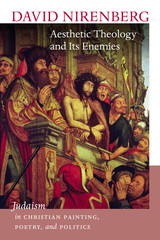
Aesthetic Theology and Its Enemies
Judaism in Christian Painting, Poetry, and Politics
David Nirenberg
Brandeis University Press, 2015
Through most of Western European history, Jews have been a numerically tiny or entirely absent minority, but across that history Europeans have nonetheless worried a great deal about Judaism. Why should that be so? This short but powerfully argued book suggests that Christian anxieties about their own transcendent ideals made Judaism an important tool for Christianity, as an apocalyptic religion—characterized by prizing soul over flesh, the spiritual over the literal, the heavenly over the physical world—came to terms with the inescapable importance of body, language, and material things in this world. Nirenberg shows how turning the Jew into a personification of worldly over spiritual concerns, surface over inner meaning, allowed cultures inclined toward transcendence to understand even their most materialistic practices as spiritual. Focusing on art, poetry, and politics—three activities especially condemned as worldly in early Christian culture—he reveals how, over the past two thousand years, these activities nevertheless expanded the potential for their own existence within Christian culture because they were used to represent Judaism. Nirenberg draws on an astonishingly diverse collection of poets, painters, preachers, philosophers, and politicians to reconstruct the roles played by representations of Jewish “enemies” in the creation of Western art, culture, and politics, from the ancient world to the present day. This erudite and tightly argued survey of the ways in which Christian cultures have created themselves by thinking about Judaism will appeal to the broadest range of scholars of religion, art, literature, political theory, media theory, and the history of Western civilization more generally.
[more]
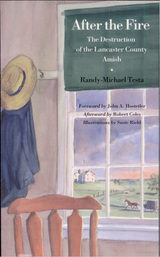
After the Fire
The Destruction of the Lancaster County Amish
Randy-Michael Testa
Brandeis University Press, 1992
Lancaster County, Pennsylvania is best known for its abundantly productive farmland and for the Amish and other “Plain People” who have made their home there since colonial times. Now both of these unique features are in danger of being permanently destroyed. “The Garden Spot of America” loses more than 20 acres of farmland every day to accelerated development. And the Amish, with a population that has doubled in the past 20 years and little land left to farm, tired of living in a fish-bowl for five million tourists a year, and frustrated by changing regulations, are moving out. They are going to Kentucky, Tennessee, Indiana -- anywhere to get away from “Amish Country.” Randy Testa initially traveled to Lancaster County in the summer of 1988 to research his dissertation, never intending to become involved personally in county affairs. But living with an Amish family that summer he saw firsthand the trials they faced: constant streams of gawking tourists, the daily paving-over of rich farmland, and the greed and complicity of local officials. Realizing that the quiet, nonresistant Amish would not fight against these destructive influences, Testa felt called to speak out on their behalf. Thus began the continuing moral journey that is at the heart of After the Fire. It is a story of family and farming, community and faith, morality as practiced by the Amish in daily life. And, ultimately, it is about our own world, for as Testa writes, we must look to the Amish to “point out how far we have strayed.” The book is illustrated with 20 charcoal drawings by Amish artist Susie Riehl. The drawings are as understated as the Amish themselves, simple yet striking sketches from within a threatened world. In this final decade of the twentieth century, a life-and-death struggle is being played out in Lancaster County: between land speculation and land stewardship, between material wealth and moral worth, between unrestrained growth and “the ties that bind.” The Amish are at the center of the conflict, trying to maintain their unique community in the face of increasing encroachment from the outside. Randy Testa stands as a witness to their struggle, telling “the story of a people on the verge of conflagration.”
[more]
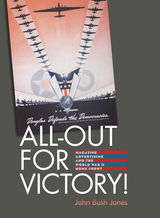
All-Out for Victory!
Magazine Advertising and the World War II Home Front
John Bush Jones
Brandeis University Press, 2009
Following the attack on Pearl Harbor and the entry of the United States into World War II, many commercial advertisers and their Madison Avenue ad agencies instantly switched from selling products and services to selling the home front on ways to support the war. Ads by major manufacturers showcased how their factories had turned to war production, demonstrating their participation in the war and helping people understand, for instance, that they couldn’t buy a new washing machine because the company was making munitions. Other ads helped civilians cope with wartime rationing and shortages by offering advice on how to make leftovers tasty, make shoes last, and keep a car in good working order. Ads also encouraged Victory Gardens, scrap collecting, giving blood, and (most important) buying War Bonds. In this book, Jones examines hundreds of ads from ten large-circulation news and general-interest magazines of the period. He discusses motivational war ads, ads about industrial and agricultural support of the war, ads directed at uplifting the morale of civilians and GIs, and ads promoting home front efficiency, conservation, and volunteerism. Jones also includes ads praising women in war work and the armed forces and ads aimed at recruiting more women. Taken together, war ads in national magazines did their part to create the most efficient home front possible in order to support the war effort.
[more]
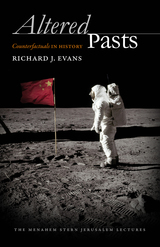
Altered Pasts
Counterfactuals in History
Richard J. Evans
Brandeis University Press, 2014
A bullet misses its target in Sarajevo, a would-be Austrian painter gets into the Viennese academy, Lord Halifax becomes British prime minister in 1940 instead of Churchill: seemingly minor twists of fate on which world-shaking events might have hinged. Alternative history has long been the stuff of parlor games, war-gaming, and science fiction, but over the past few decades it has become a popular stomping ground for serious historians. The historian Richard J. Evans now turns a critical, slightly jaundiced eye on a subject typically the purview of armchair historians. The book’s main concern is examining the intellectual fallout from historical counterfactuals, which the author defines as “alternative versions of the past in which one alteration in the timeline leads to a different outcome from the one we know actually occurred.” What if Britain had stood at the sidelines during the First World War? What if the Wehrmacht had taken Moscow? The author offers an engaging and insightful introduction to the genre, while discussing the reasons for its revival in popularity, the role of historical determinism, and the often hidden agendas of the counterfactual historian. Most important, Evans takes counterfactual history seriously, looking at the insights, pitfalls, and intellectual implications of changing one thread in the weave of history. A wonderful critical introduction to an often-overlooked genre for scholars and casual readers of history alike.
[more]
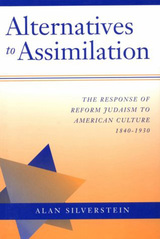
Alternatives to Assimilation
The Response of Reform Judaism to American Culture, 1840–1930
Alan Silverstein
Brandeis University Press, 1995
Explores the influence of American culture and history on the development of Reform Jewish institutions. Brandeis Series in American Jewish History, Culture, and Life.
[more]
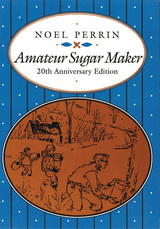
Amateur Sugar Maker
Noel Perrin
Brandeis University Press, 1992
Noel Perrin’s delightful account of building a sugarhouse and making maple sugar in Vermont first appeared twenty years ago. Like a sturdy New England farmhouse, Perrin has added to it over the years to reflect his subsequent sugaring experiences, and includes in this latest edition a “postpostpostscript.” His celebration of simple, hard work to produce a “quite wonderful, maybe even sacred article” has not been diminished by plastic tubing, thrip infestations, and the strange new market for Vermont sap water.
[more]
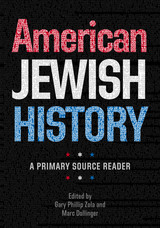
American Jewish History
A Primary Source Reader
Edited by Gary Phillip Zola and Marc Dollinger
Brandeis University Press, 2014
Presenting the American Jewish historical experience from its communal beginnings to the present through documents, photographs, and other illustrations, many of which have never before been published, this entirely new collection of source materials complements existing textbooks on American Jewish history with an organization and pedagogy that reflect the latest historiographical trends and the most creative teaching approaches. Ten chapters, organized chronologically, include source materials that highlight the major thematic questions of each era and tell many stories about what it was like to immigrate and acculturate to American life, practice different forms of Judaism, engage with the larger political, economic, and social cultures that surrounded American Jews, and offer assistance to Jews in need around the world. At the beginning of each chapter, the editors provide a brief historical overview highlighting some of the most important developments in both American and American Jewish history during that particular era. Source materials in the collection are preceded by short headnotes that orient readers to the documents’ historical context and significance.
[more]
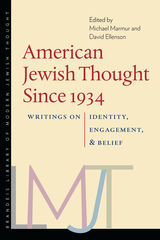
American Jewish Thought Since 1934
Writings on Identity, Engagement, and Belief
Edited by Michael Marmur and David Ellenson
Brandeis University Press, 2020
What is the role of Judaism and Jewish existence in America? And what role does America play in matters Jewish? This anthology considers these questions and offers a look at how the diverse body of Jewish thought developed within the historical and intellectual context of America.
In this volume, editors Michael Marmur and David Ellenson bring together the distinctive voices of those who have shaped the bold and shifting soundscape of American Jewish thought over the last few generations. The contributors tackle an array of topics including theological questions; loyalty and belonging; the significance of halakhic, spiritual, and ritual practice; secularization and its discontents; and the creative recasting of Jewish peoplehood. The editors are careful to point out how a plurality of approaches emerged in response to the fundamental ruptures and challenges of continuity posed by the Holocaust, the establishment of the state of Israel, and the civil rights movement in the twentieth century.
This volume also includes a wide swath of the most distinctive currents and movements over the last eighty years: post-Holocaust theology, secular forms of Jewish spirituality, ultra-orthodoxy, American neo-orthodoxy, neo-Hasidism, feminism and queer theory, diasporist critiques of Zionism, and Zionist militancy. This collection will serve as both a testament to the creativity of American Jewish thought so far, and as an inspiration for the new thinkers of its still unwritten future.
In this volume, editors Michael Marmur and David Ellenson bring together the distinctive voices of those who have shaped the bold and shifting soundscape of American Jewish thought over the last few generations. The contributors tackle an array of topics including theological questions; loyalty and belonging; the significance of halakhic, spiritual, and ritual practice; secularization and its discontents; and the creative recasting of Jewish peoplehood. The editors are careful to point out how a plurality of approaches emerged in response to the fundamental ruptures and challenges of continuity posed by the Holocaust, the establishment of the state of Israel, and the civil rights movement in the twentieth century.
This volume also includes a wide swath of the most distinctive currents and movements over the last eighty years: post-Holocaust theology, secular forms of Jewish spirituality, ultra-orthodoxy, American neo-orthodoxy, neo-Hasidism, feminism and queer theory, diasporist critiques of Zionism, and Zionist militancy. This collection will serve as both a testament to the creativity of American Jewish thought so far, and as an inspiration for the new thinkers of its still unwritten future.
[more]
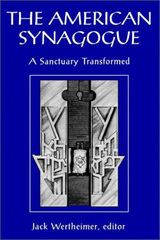
The American Synagogue
A Sanctuary Transformed
Edited by Jack Wertheimer
Brandeis University Press, 1995
When first published in 1987, The American Synagogue quickly established itself as the standard work on the subject. The strength of the book lies in its combination of broad overviews of denominational differentiation that took place and case studies drawing from many geographical regions and emphasizing themes ranging from effects of immigration on synagogue life to changing roles of women. The book has become an important comparative resource for students of American religious life, particularly in its examination of how religious communities change over time.
[more]
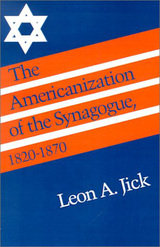
The Americanization of the Synagogue, 1820–1870
Leon A. Jick
Brandeis University Press, 1992
The Americanization of the Synagogue, 1820–1870
[more]
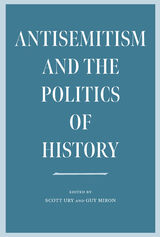
Antisemitism and the Politics of History
Edited by Scott Ury and Guy Miron
Brandeis University Press, 2023
This groundbreaking anthology addresses the history and challenges of using “antisemitism” and related terms as tools for historical analysis and public discourse. Drawing together seventeen chapters by prominent scholars from Europe, Israel, and the United States, the volume encourages readers to rethink assumptions regarding the nature and meaning of Jewish history and the history of relations between Jews and non-Jews.
The book begins with a revised and updated version of David Engel’s seminal essay “Away from a Definition of Antisemitism.” Subsequent contributions by renowned specialists in ancient, medieval, and modern history, religious studies, and other fields explore the various and changing definitions and uses of the term “antisemitism” in a range of contexts, including ancient Rome and Greece, the Byzantine Empire, medieval Europe, early modern and modern Europe, North America, and the United Kingdom. The volume also includes a section that focuses on the Second World War, including the Holocaust and its memory. Engel offers a contemporary response to conclude the book.
First published in Hebrew in 2020 as a special issue of the journal Zion: A Quarterly for Research in Jewish History in cooperation with the Zalman Shazar Center in Jerusalem, this compelling collection has already had an impact on the study of antisemitism in Israel. It is certain to become a critical resource for scholars, policymakers, and journalists researching antisemitism, Holocaust studies, and related fields.
The book begins with a revised and updated version of David Engel’s seminal essay “Away from a Definition of Antisemitism.” Subsequent contributions by renowned specialists in ancient, medieval, and modern history, religious studies, and other fields explore the various and changing definitions and uses of the term “antisemitism” in a range of contexts, including ancient Rome and Greece, the Byzantine Empire, medieval Europe, early modern and modern Europe, North America, and the United Kingdom. The volume also includes a section that focuses on the Second World War, including the Holocaust and its memory. Engel offers a contemporary response to conclude the book.
First published in Hebrew in 2020 as a special issue of the journal Zion: A Quarterly for Research in Jewish History in cooperation with the Zalman Shazar Center in Jerusalem, this compelling collection has already had an impact on the study of antisemitism in Israel. It is certain to become a critical resource for scholars, policymakers, and journalists researching antisemitism, Holocaust studies, and related fields.
[more]
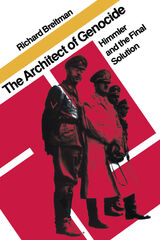
The Architect of Genocide
Himmler and the Final Solution
Richard Breitman
Brandeis University Press, 1992
Among the Nazi leaders, Heinrich Himmler was, as Richard Breitman observes in this ground- breaking study, an easy man to underestimate—short, pudgy, near-sighted, chinless. Yet Himmler holds a peculiarly memorable place in the roster of Nazi war criminals: he was the man most closely associated with the creation and operation of the Final Solution, the programme of formal mass murder responsible for the deaths of six million Jews in death camps. Thus, to understand the Holocaust it is first necessary to understand Himmler, and it is this The Architect of Genocide at last permits us to do. Drawing on thousands of published and unpublished sources—ranging from the Nuremburg War Crimes trial records to papers held in the Central State Archives of the October Revolution of the Ukrainian SSR in Kiev—Breitman shows us the man himself, growing from unlikeable boyhood to be the perfect bureaucrat, seemingly the antithesis of the mad policies he espoused. At the same time, with unchallengeable authority, he presents us with the hitherto mysterious and much—debated facts about the origins of those policies, establishing among other things that before the war, Himmler had plans to murder all German Jews who would not- or could not—leave the country and that as early as 1939, Himmler was considering the use of gas chambers and crematoriums.
[more]
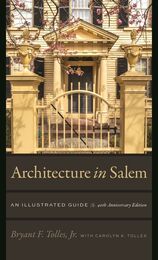
Architecture in Salem
An Illustrated Guide
Bryant F. Tolles, Jr.
Brandeis University Press, 2023
The definitive guide to Salem’s architecture, now available in a new edition.
Salem, Massachusetts is home to one of the largest extant collections of historical architecture in the entire nation. In this long-awaited new edition, noted architectural historian Bryant F. Tolles, Jr., presents an illustrated guide and walking tour covering more than three centuries of building styles and types. The book discusses over 350 buildings and complexes, with individual entries and photographs of nearly 230 structures. The material has been arranged according to eight tour districts, each accompanied by an introduction and a map.
A joy for the avid walker and arm-chair enthusiast alike, this book is an essential guide to the architecture of Salem from the early seventeenth century through the Georgian, Federal, Victorian, modern, and contemporary periods. Updated with new maps; color illustrations; a preface by Lynda Roscoe Hartigen, executive director and CEO of the Peabody Essex Museum; and a foreword by Steven Mallory, manager of historic structures and landscapes at the Peabody Essex Museum.
Salem, Massachusetts is home to one of the largest extant collections of historical architecture in the entire nation. In this long-awaited new edition, noted architectural historian Bryant F. Tolles, Jr., presents an illustrated guide and walking tour covering more than three centuries of building styles and types. The book discusses over 350 buildings and complexes, with individual entries and photographs of nearly 230 structures. The material has been arranged according to eight tour districts, each accompanied by an introduction and a map.
A joy for the avid walker and arm-chair enthusiast alike, this book is an essential guide to the architecture of Salem from the early seventeenth century through the Georgian, Federal, Victorian, modern, and contemporary periods. Updated with new maps; color illustrations; a preface by Lynda Roscoe Hartigen, executive director and CEO of the Peabody Essex Museum; and a foreword by Steven Mallory, manager of historic structures and landscapes at the Peabody Essex Museum.
[more]
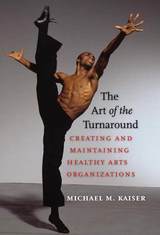
The Art of the Turnaround
Creating and Maintaining Healthy Arts Organizations
Michael M. Kaiser
Brandeis University Press, 2008
Many arts organizations today find themselves in financial difficulties because of economic constraints inherent in the industry. While other companies can improve productivity through the use of new technologies or better systems, these approaches are not available in the arts. Hamlet requires the same number of performers today as it did in Shakespeare’s time. The New York Philharmonic requires the same number of musicians now as it did when Tchaikovsky conducted it over one hundred years ago. Costs go up, but the size of theaters and the price resistance of patrons limit what can be earned from ticket sales. Therefore, the performing arts industry faces a severe gap between earnings and expenses. Typical approaches to closing the gap—raising ticket prices or cutting artistic or marketing expenses—don’t work. What, then, does it take to create and maintain a healthy arts organization? Michael M. Kaiser has revived four major arts organizations: the Kansas City Ballet, the Alvin Ailey American Dance Theater, American Ballet Theatre, and London’s Royal Opera House. In The Art of the Turnaround he shares with readers his ten basic rules for bringing financially distressed arts organizations back to life and keeping them strong. These rules cover the requirements for successful leadership, the pitfalls of cost cutting, the necessity of extending the programming calendar, the centrality of effective marketing and fund raising, and the importance of focusing on the present with a positive public message. In chapters organized chronologically, Kaiser brings his ten rules vividly to life in discussions of the four arts organizations he is credited with saving. The book concludes with a chapter on his experiences at the John F. Kennedy Center for the Performing Arts, an arts organization that needed an artistic turnaround when he became the president in 2001 and that today exemplifies in practice many of the ten rules he discusses throughout his book.
[more]
READERS
Browse our collection.
PUBLISHERS
See BiblioVault's publisher services.
STUDENT SERVICES
Files for college accessibility offices.
UChicago Accessibility Resources
home | accessibility | search | about | contact us
BiblioVault ® 2001 - 2024
The University of Chicago Press



